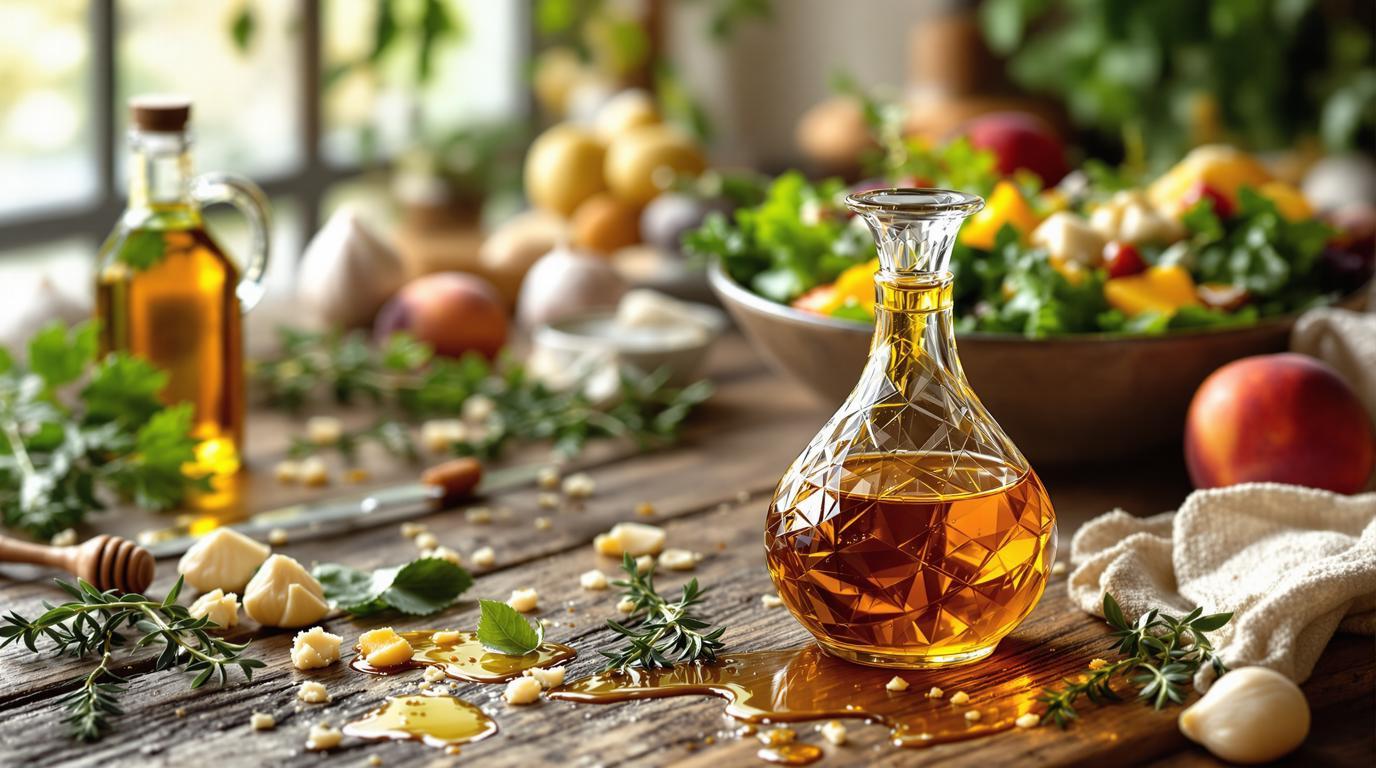There’s something magical about classic vinaigrettes that takes me back to my grandmother’s kitchen. As a young chef-in-training, I would watch her hands move with practiced precision as she whisked together simple ingredients that transformed ordinary salads into memorable experiences. Her honey-balsamic vinaigrette was a particular favorite – striking that perfect balance between sharp acidity and gentle sweetness without becoming cloying. Today, I’m sharing my refined version of this timeless dressing that has delighted dinner guests for generations.
The Story Behind Honey-Balsamic Vinaigrette 📖
This vinaigrette’s lineage traces back to Mediterranean culinary traditions, where the marriage of honey and vinegar has been celebrated since ancient Roman times. What fascinates me about this simple sauce is how it reflects Renaissance-era Italian preservation techniques – when aged balsamic became a treasured condiment. My grandmother learned it from her mother, who insisted that good vinaigrette should “wake up your taste buds without shouting at them.” This philosophy perfectly captures what makes this recipe special: vibrant flavor that enhances rather than overwhelms.
During my early years at the Culinary Institute, I discovered that many restaurant kitchens relied on sugar-laden dressings. Reconnecting with my grandmother’s approach reminded me that honey provides a more nuanced sweetness with mineral complexity that refined sugar simply cannot match.
Essential Ingredients 🧾
For approximately one cup of vinaigrette:
- 2 tablespoons honey (28g) – pure, unpasteurized if possible
- 1 garlic clove, crushed
- 1 tablespoon Dijon mustard (15g)
- ¼ cup aged balsamic vinegar (60ml)
- ¾ cup extra virgin olive oil (180ml)
- ½ teaspoon kosher salt
- ½ teaspoon freshly ground black pepper
Each ingredient plays a crucial role: the mustard acts as an emulsifier binding oil and vinegar together, while garlic provides a savory counterpoint to the honey’s sweetness. Using aged balsamic vinegar makes a world of difference – its complex flavor profile adds depth you simply can’t achieve with younger varieties.
Step-by-Step Instructions 📝
1. In a medium bowl, combine honey, crushed garlic, Dijon mustard, salt, and pepper.
2. Whisk thoroughly until the mixture becomes smooth and the honey fully dissolves.
3. Gradually add the balsamic vinegar while continuing to whisk.
4. In a slow, steady stream, pour in the olive oil while whisking vigorously to emulsify.
5. Taste and adjust seasoning if necessary.
6. Transfer to a glass jar with a tight-fitting lid for storage.
Chef’s Secret Techniques 🤫
The magic of a perfect vinaigrette lies in the emulsification process. I’ve found that creating a stable base with the mustard, honey, and seasonings before adding any liquid creates a more stable emulsion. When adding the oil, patience is crucial – pour it in the thinnest possible stream while whisking continuously. This method creates microscopic droplets of oil suspended in the vinegar mixture, resulting in that silky texture we’re after.
Chef’s Note: Leave the crushed garlic clove in the jar while storing for a gentle flavor infusion that develops over time. Just remember to remove it after 24 hours to prevent an overwhelming garlic presence. This slow extraction method yields a more nuanced flavor than minced garlic incorporated directly.
For those who enjoy exploring variations, try infusing the vinaigrette with fresh herbs like thyme or tarragon. Simply add a sprig to the jar and remove after a day for a subtle aromatic dimension that pairs beautifully with summer salads like Peach Caprese.
Serving & Presentation Tips 🍽️
This versatile vinaigrette shines brightest when drizzled over bitter greens like arugula or endive, as the sweetness provides perfect contrast. It also makes an exceptional marinade for chicken before preparing Mediterranean-inspired dishes.
For a dinner party presentation that always impresses, serve the vinaigrette in a small glass cruet alongside a fresh salad, allowing guests to dress their portions. The rich amber color of the dressing is visually striking – a detail not lost on those who appreciate that we eat first with our eyes.
Don’t limit this vinaigrette to salads! It makes a spectacular finishing drizzle for braised meats or roasted vegetables, and can even transform simple grilled bread into an elevated appetizer.
No honey-balsamic vinaigrette on hand? You can create a quick approximation by whisking together 1 tablespoon of classic vinaigrette with ½ teaspoon honey and a few drops of balsamic glaze.
In my decades of cooking professionally, I’ve created countless complex sauces and reductions, but I continually return to this simple vinaigrette. It reminds me that cooking isn’t always about elaborate techniques – sometimes the most memorable flavors come from honoring traditions and understanding the perfect balance of a few quality ingredients. I hope this brings as much joy to your table as it has to mine for all these years. 💕
